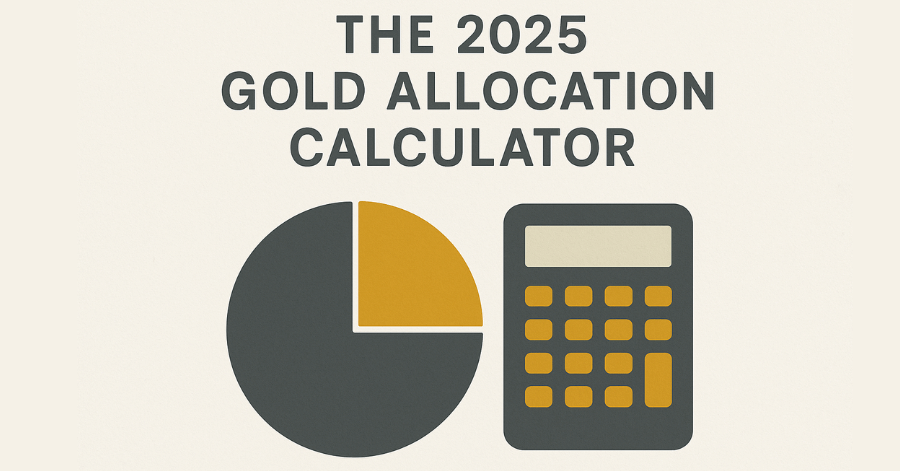Key Takaways:
- A Strategic Necessity for 2025: Gold allocation is no longer a niche strategy. In the era of the ‘Rio Reset,’ it is a crucial tool for preserving wealth against persistent inflation and currency debasement.
- The 5% to 10% Guideline: Financial professionals often recommend allocating 5% to 10% of a portfolio to gold. This provides a meaningful hedge without significantly hindering the growth potential of other assets.
- Personalization is Key: While the 5-10% rule is a solid starting point, your ideal allocation depends on your personal age, risk tolerance, and financial goals.
- Diverse Investment Vehicles: A gold allocation can be built using different tools—including physical gold, ETFs, and mining stocks—each with a unique risk and reward profile designed for different investor goals.
Gold Allocation Percentage
Why Gold Allocation Matters in 2025: The ‘Rio Reset’ and Your Retirement
The global economic order is undergoing a fundamental transformation.
This dynamic, which we identify as the  ‘Rio Reset,’ is characterized by persistent inflation, unprecedented levels of government debt, and a strategic move by the world’s central banks to diversify away from the U.S. dollar.
‘Rio Reset,’ is characterized by persistent inflation, unprecedented levels of government debt, and a strategic move by the world’s central banks to diversify away from the U.S. dollar.
Consequently, investors are realizing that a traditional 60/40 portfolio of stocks and bonds may no longer provide adequate protection. This has made strategic gold portfolio allocation an essential consideration for anyone serious about preserving their wealth through 2025 and beyond. This guide will provide a clear framework for determining the right allocation for you.
The 5% to 10% Rule: A Balanced Approach to Wealth Protection
So, how much gold should you own? For years, a common guideline from financial professionals has been to allocate between 5% and 10% of an investment portfolio to gold. The World Gold Council, a leading authority on the precious metals market, has published extensive research supporting this range as a way to enhance risk-adjusted returns.
Let’s break down the logic in simple terms:
- The “Insurance” Policy: An allocation in this range is substantial enough to provide a meaningful hedge during a stock market downturn or a period of high inflation. It acts as a stabilizing force when other assets are falling.
- The “Growth” Enabler: At the same time, this allocation is modest enough that it doesn’t significantly drag on your portfolio’s overall growth potential during bull markets for stocks.
Think of it as the “Goldilocks principle” for your portfolio: not too much, not too little. It’s a balanced strategy that aims for protection without sacrificing the opportunity for growth.
The 2025 Gold Allocation Calculator

Click Here To Gain Access!
While the 5-10% rule is an excellent starting point, your ideal allocation is personal. It depends on your age, overall portfolio size, and tolerance for risk. To help you find your strategic starting point, use our interactive calculator below.
Building Your Gold Allocation: Deeper Dives
Once you have a target allocation, the next step is to understand how to build it. This involves exploring gold’s historical role, comparing investment vehicles, and managing risk. Below are summaries of our in-depth guides designed to help you make informed decisions.
A Historical Analysis: Gold’s Performance in Financial Crisis
History provides a powerful lesson on gold’s role as a safe-haven asset. During nearly every major financial crisis of the past century—from the Great Depression of the 1930s to the 2008 Financial Crisis and the 2020 market crash—gold has demonstrated its ability to preserve wealth while other assets declined. Understanding this track record is crucial for appreciating its role as portfolio insurance.
 Read our complete guide: A Historical Analysis: How Gold Performs in Financial Crises
Read our complete guide: A Historical Analysis: How Gold Performs in Financial Crises
Gold vs. Stocks vs. Bonds: A 2025 Correlation Deep Dive
Gold’s primary benefit is its low correlation with traditional financial assets. This means its price often moves independently of stocks and bonds. In a diversified portfolio, this is the key to reducing volatility and protecting against systemic risk. Our deep-dive analysis explores the most recent correlation data for 2025, showing you exactly how gold interacts with other asset classes in today’s market.
 See the data: Gold vs. Stocks vs. Bonds: A 2025 Correlation Deep Dive
See the data: Gold vs. Stocks vs. Bonds: A 2025 Correlation Deep Dive
Physical Gold, ETFs, or Mining Stocks: Which Is Right for You?
“Investing in gold” is not a one-size-fits-all strategy. You can own physical bullion (coins and bars), invest in Gold ETFs that trade like stocks, or buy shares in gold mining companies. Each vehicle has a unique risk, reward, and cost profile. Your choice will depend on your goals, whether you prioritize direct ownership, liquidity, or growth potential.
 Explore the options: Physical Gold, ETFs, or Mining Stocks: Which is Right for You?
Explore the options: Physical Gold, ETFs, or Mining Stocks: Which is Right for You?
Advanced Risk Management for Your Gold Position
While gold is a risk-management tool, any investment carries its own risks. For precious metals, these can include price volatility and the operational risks of storage. A sophisticated strategy involves more than just buying; it includes knowing how to rebalance your position, manage costs, and secure your assets properly.
 Learn more: Advanced Risk Management for Precious Metals Portfolios
Learn more: Advanced Risk Management for Precious Metals Portfolios
Conclusion: Take a Strategic Step Toward a Secure Retirement
To conclude, allocating a portion of your portfolio to gold is a prudent and time-tested strategy for navigating the economic uncertainties of 2025. In an environment shaped by the ‘Rio Reset,’ protecting your purchasing power is just as important as growing your assets.
By starting with the 5% to 10% guideline, utilizing our tools to determine your allocation, and exploring our expert guides, you can build a more resilient and diversified portfolio. The most important action you can take is the first one. Take a moment to calculate your strategic allocation and speak with a specialist to see how a position in gold can help secure your financial future.
Frequently Asked Questions (FAQ)
Q: What do major financial institutions say about gold allocation?
A:Major investment banks and research institutions generally recommend including gold in diversified portfolios as a hedge against inflation and market volatility. Multiple studies and analyses from the World Gold Council, Sprott, WisdomTree, and others suggest that allocations between 5% and 15% (and in some recent research, even higher) can improve a portfolio’s risk-adjusted returns, reduce volatility, and provide protection during economic downturns. For example, the World Gold Council has found that portfolios with just 5% gold allocation improved their Sharpe ratio by 12% while reducing overall volatility1. Recent research also indicates that optimal allocations may range from 10% to 19%, depending on the investment horizon and market conditions.
Q: Is it legal for me to own investment-grade gold bullion in the U.S.?
A:Yes. Private ownership of investment-grade gold bullion is fully legal in the United States, with no federal restrictions on the quantity an individual can hold. The U.S. Mint, a bureau of the Department of the Treasury, actively produces and sells gold bullion coins such as the American Eagle specifically for investors. The last federal restrictions on private gold ownership were repealed in 1974 (supporting source: U.S. Mint).
Q: Are my profits from gold taxed differently than my profits from stocks?
A:Yes. According to the Internal Revenue Service (IRS), physical gold and most gold ETFs are classified as “collectibles.” Gains from selling collectibles are taxed at a maximum federal rate of 28%, regardless of the holding period. This is higher than the long-term capital gains rates that apply to stocks held for more than one year. However, taxes on gold can be deferred if it is held within certain tax-advantaged accounts, such as a Gold IRA (supporting source: IRS Topic No. 409).
Q: Why have central banks been buying record amounts of gold?
A:Central banks have been record net purchasers of gold in recent years for several strategic reasons. According to the World Gold Council, the main motivations are to diversify national reserves away from heavy reliance on the U.S. dollar, hedge against geopolitical and economic risks, and hold an asset with no counterparty risk. Gold’s role as a universally accepted store of value makes it attractive to central banks seeking to protect their reserves in uncertain times.









10 Comments
Comments are closed.